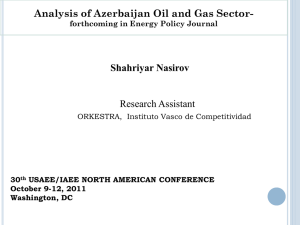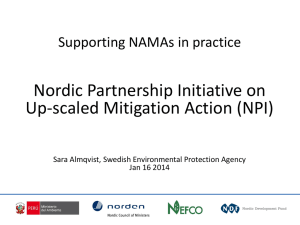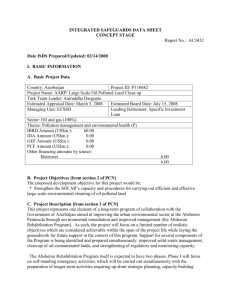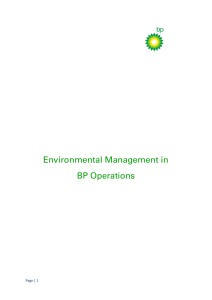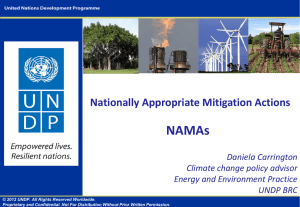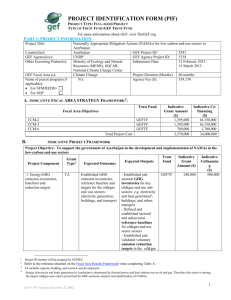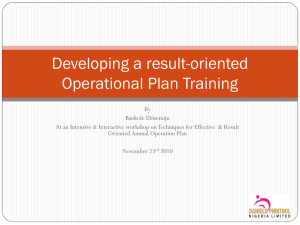GEF-UNDP presenta
advertisement
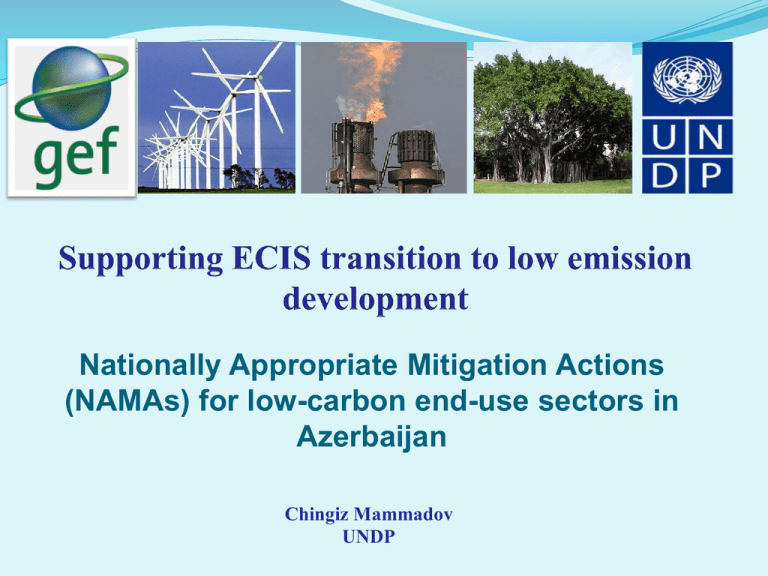
Nationally Appropriate Mitigation Actions (NAMAs) for low-carbon end-use sectors in Azerbaijan Chingiz Mammadov UNDP Project’s Genesis Continuous Communication with the National Government. Guiding Document: UNDAF for Azerbaijan for 2011-2015 1. 2. Discussions/Series of meetings with the Government in 2012-2013 on possible CC mitigation actions 3. Assessing the State Oil Company of Azerbaijan Republic (SOCAR) as a potential partner in the Project 4. Looking for possible GEF financing: GEF-5 allocation for Azerbaijan under Climate Change: since total $ 6.5mln, sufficient for financing the NAMA project: required amount: $3.57 mln Result: Project Concept Developed (PIF/PPG formulated) Project Preparation 5. Project Document Preparation in 2013-2014: Team of Local and International Experts formed Series of field trips, meetings, discussions with the representatives of SOCAR were held; CC Mitigation opportunities and Potential NAMAs are discussed with SOCAR, Co-financing options are discussed and agreed with SOCAR and UNDP Project Document has been prepared Guiding Documents and Principles UNDAF: By 2015, non-oil development policies result in better economic status, decent work opportunities and a healthier environment in all regions and across all social groups UNDP Strategic Plan Primary Outcome: Relevant national strategies, policies, and capacities strengthened to address environmental degradation, promote the green economy, and reduce vulnerability to climate change. UNDP Strategic Plan Secondary Outcome: Relevant regulatory and institutional frameworks established to safeguard energy security, enable greater energy efficiency in production and consumption cycles and a wider use of renewable energy Project Summary • Project objective: Development of NAMAs for low-carbon end-use sectors (buildings, transport, associated gas for residential areas) • Implementation Period: 5 years • Partners: State Oil Company of Azerbaijan Republic (SOCAR) Ministry of Ecology and Natural Resources (MENR) • Project Budget: Total: 35,470 mln USD GEF Financing: 3,570 mln USD; UNDP: 200,000 USD • Expected CC Mitigation: Total direct emission reductions over 0.56 mln t CO2eq and Total indirect emission reductions of 6.24 mln t CO2eq Project Components/Outcomes Outcome 1 Assessment of GHG emission mitigation potentials and target setting Outcome 2 Development of NAMAs in oil & gas end-use sectors Outcome 3 Implementation of NAMAs in the oil & gas end-use sector Outcome 4 MRV system and national registry for mitigation actions in the energy generation and end-use sectors Nationally Appropriated Mitigation Actions NAMA 1: SOCAR’s Green Building Program implemented Content: making use of energy efficient technologies and practices in new and existing residential and office buildings : NAMA 2: Sustainable Transport at SOCAR implemented Content: introducing alternative fuel sources such as electric vehicles, introducing energy efficient fleet management practices NAMA 3: SOCAR’s Associated Gas Capturing Program implemented Content: capturing low-pressure associated gas being currently vented at one of SOCAR’s largest on-shore oil & gas production units at Siyazan (Siyazanneft) and providing this to nearby citizens Establishing MRV system Implementation of MRV system and national registry for mitigation actions in the energy generation and end-use sectors Defined and established sectoral and sub-sectoral reference baselines for oil & gas end-use sectors Established sub-sectoral GHG inventories for key oil & gas end-use sub-sectors Established an operational national registry mechanism for mitigation actions in the oil & gas end-use sectors Accurate measurement and accounting of actual GHG emission reductions in the oil&gas end-use sectors Expected Challenges 1. Matching Project Activities with SOCAR’s activities 2. Establishing and using a feedback mechanism ensuring that the Project Activities remain in line with the country, CC and SOCAR priorities 3. Risk management 4. Technology transfer and making sure that the best available technical expertise is provided under the project 5. Making sure that the project results are sustainable and replicable Thank you for your attention
